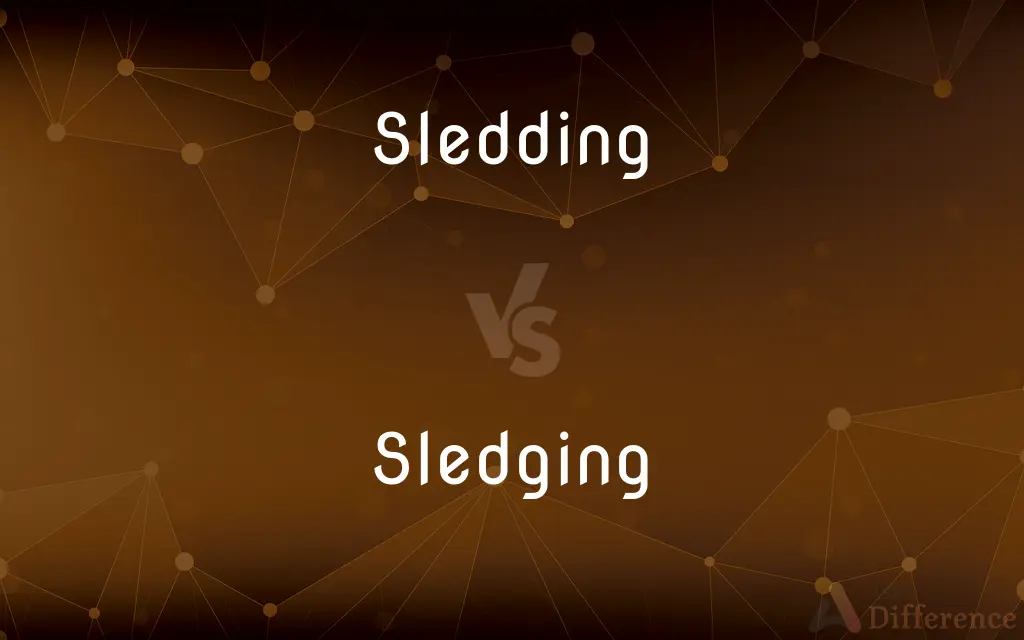Sledding vs. Sledging — What's the Difference?
By Tayyaba Rehman & Urooj Arif — Updated on March 18, 2024
Sledding involves sliding down snowy slopes on a sled for recreation, focusing on simplicity and fun. Sledging, while similar, can also refer to using a heavy sled for transport or work, especially in polar regions.

Difference Between Sledding and Sledging
Table of Contents
ADVERTISEMENT
Key Differences
Sledding is primarily a winter recreational activity where individuals or groups slide down snow-covered hills or slopes using a sled, toboggan, or similar device. It's popular among all ages for its simplicity and the thrill of gliding over snow. Sledging, on the other hand, often involves the use of a heavier sled or sledge designed for transporting goods or people across snow and ice. This distinction is more pronounced in regions where such activities are essential for daily life or expeditions, such as in polar areas.
While both activities use similar equipment, the design and build of the sleds or sledges vary significantly depending on their intended use. Recreational sledding sleds are typically lightweight and designed for speed and maneuverability. Conversely, sledges used for transportation or work are sturdier, often equipped with runners for stability and capable of bearing heavy loads.
In terms of cultural significance, sledding is widely regarded as a leisure activity, often associated with childhood and family outings in snowy regions. Sledging, however, can have important cultural and historical roles in communities where it has been a traditional means of transport during winter months, such as among Indigenous peoples of the Arctic.
The terminology can also vary by region, with "sledding" more commonly used in North America and "sledging" in other English-speaking countries. Despite this, the context usually makes the intended meaning clear, whether it's for fun or functional purposes.
The experience of sledding is typically characterized by casual, short rides down local hills or slopes, making it accessible and popular in many snowy regions. Sledging, particularly in the context of expeditions or work, involves longer distances and is often part of broader activities like exploration, hunting, or transport.
ADVERTISEMENT
Comparison Chart
Primary Use
Recreation, fun on snow
Transport or work across snow and ice
Equipment
Lightweight sleds for speed and maneuverability
Heavier sleds or sledges for stability and heavy loads
Cultural Significance
Associated with leisure and childhood memories
May have historical or functional significance
Regional Usage
More common in North America
Used in other English-speaking countries and polar regions
Experience
Short, casual rides for enjoyment
Can involve long distances for specific purposes
Compare with Definitions
Sledding
The act of riding on a sled down a snow-covered hill.
They went sledding in the park after the snowstorm.
Sledging
Transporting goods or people across snow using a sledge.
They used sledging to move supplies to the base camp.
Sledding
Using a lightweight sled designed for speed.
Their new sled made sledding even more exciting.
Sledging
Involving the use of sledges in traditional practices.
Indigenous communities have traditions of sledging.
Sledding
Participating in informal sledding events.
The neighborhood kids organized a sledding race.
Sledging
A method of travel over snow and ice with heavy sleds.
Sledging has been crucial for polar explorations.
Sledding
Recreational activity without specific rules.
Sledding down the hill, they felt a rush of adrenaline.
Sledging
Engaging in long-distance sledging expeditions.
The team embarked on a sledging journey across the glacier.
Sledding
A winter sport or pastime involving a sled.
Sledding is their favorite winter activity.
Sledging
Utilizing sledges for specific tasks in snowy environments.
Sledging was the most efficient way to transport their gear.
Sledding
The act of using a sled.
Sledging
A vehicle mounted on runners drawn by work animals, such as horses or dogs, and used for transporting loads across ice, snow, and rough ground.
Sledding
Sledding, sledging or sleighing is a winter sport typically carried out in a prone or seated position on a vehicle generically known as a sled (North American), a sledge (British), or a sleigh. It is the basis of three Olympic sports: luge, skeleton and bobsledding.
Sledging
To convey or travel on a sledge.
Sledding
Conditions conducive to the use of a sled.
Sledging
Present participle of sledge
Sledding
(Informal) A specific kind of progress toward a goal; the going
"The plan faces tough sledding in Congress, although it may still be instituted by a presidential decree" (Clifford Krauss).
Sledging
The act of using a sledge to travel over snow.
Sledding
Present participle of sled
Sledging
The act of using a sledgehammer to bend or crush an object.
Sledding
The act of sliding downhill, or transporting something, on a sled.
Sledging
(cricket) The practice of a fielder making insulting or comical references to an opposition batsman with the aim of distracting him
Sledding
The act of transporting or riding on a sled.
Sledding
The state of the snow which admits of the running of sleds; as, the sledding is good.
Sledding
The sport of riding on a sled or sleigh
Sledding
Advancing toward a goal;
Persuading him was easy going
The proposal faces tough sledding
Common Curiosities
Is sledding safe for all ages?
Yes, with proper safety measures like helmets and choosing appropriate slopes, sledding can be safe and enjoyable for all ages.
Why is sledging important in polar regions?
Sledging provides an essential means of transport across difficult terrain in polar regions, supporting expeditions and daily life.
How does sledging differ from sledding in purpose?
Sledging is often aimed at transportation or work, involving heavier sleds suitable for carrying loads across snow and ice.
What makes sledding popular among families?
Its simplicity, accessibility, and the fun of gliding on snow make sledding a popular family activity.
Can sledding be considered a sport?
While primarily a recreational activity, sledding can also be competitive, with races and informal competitions.
How does weather impact sledding and sledging activities?
Ideal conditions include sufficient snow cover, which affects the safety and enjoyment of sledding and the feasibility of sledging.
How do sled designs differ between sledding and sledging?
Sledding sleds are designed for leisure and speed, while sledges for work are built to be durable and carry heavy loads.
What equipment is needed for sledding?
Sledding typically requires a lightweight sled made for speed and maneuverability on snow-covered slopes.
Can sledging be a form of recreation?
Yes, sledging can also be recreational, especially in traditional contexts or as part of adventure tourism.
Are there professional sledging expeditions?
Yes, professional expeditions often use sledging for transport in challenging environments like Antarctica.
What safety precautions should be taken while sledding?
Wear protective gear, choose safe locations, and ensure the sled is in good condition.
What skills are necessary for sledging?
Skills include navigating over snow and ice, managing heavy loads, and enduring harsh conditions.
How do traditions of sledging vary around the world?
Traditions vary significantly, with some cultures using sledges for centuries as vital tools for winter survival and transport.
Can sledging equipment be used for sledding?
While possible, sledging equipment is generally heavier and not optimized for recreational sledding's speed and maneuverability.
What role does community play in sledding and sledging?
Community plays a vital role in both, from local sledding gatherings to traditional sledging practices in polar communities.
Share Your Discovery

Previous Comparison
Tapioca vs. Sago
Next Comparison
Conference vs. BanquetAuthor Spotlight
Written by
Tayyaba RehmanTayyaba Rehman is a distinguished writer, currently serving as a primary contributor to askdifference.com. As a researcher in semantics and etymology, Tayyaba's passion for the complexity of languages and their distinctions has found a perfect home on the platform. Tayyaba delves into the intricacies of language, distinguishing between commonly confused words and phrases, thereby providing clarity for readers worldwide.
Co-written by
Urooj ArifUrooj is a skilled content writer at Ask Difference, known for her exceptional ability to simplify complex topics into engaging and informative content. With a passion for research and a flair for clear, concise writing, she consistently delivers articles that resonate with our diverse audience.















































